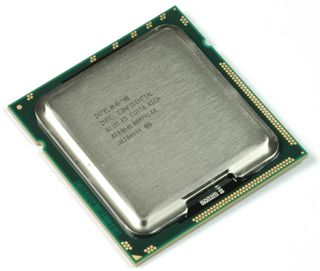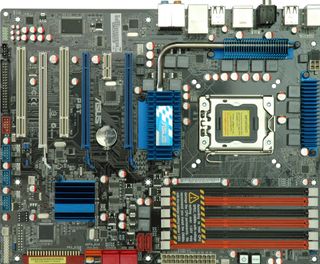Overclocking Core i7: Power Versus Performance
Hardware: Core i7 920, Asus X58, Corsair DDR3

It may not be a mainstream system yet, but we decided to use a Core i7 machine for several reasons. First of all, Core i7 is currently the fastest processor available, and we would expect performance enthusiasts to go for it if their budget allows. AMD’s Phenom II would be an almost-equivalent choice, and we've already performed this little experiment on that platform.
The second reason for using Core i7 is its power efficiency. An X58 platform with Core i7 is not a low-power solution at all. In fact, our test system required at least 109 W idle power, which is more than any Core 2 Quad system based on a 45 nm processor and a P45 platform would require. However, Core i7 is far superior to Core 2 when it comes to performance per watt, as the performance benefits usually are larger than the incremental power required.

Our platform of choice is Asus' P6T, which is an enthusiast X58 chipset motherboard. It’s not the company's top-of-the-line model, but it was designed for overclockers and other performance-seeking users nonetheless. We had no problems running Core i7 samples at more than 4.0 GHz using a Core i7 Extreme 965. We used this to ensure that the motherboard would not be bottlenecking higher overclocks on the Core i7 920, which is a much more affordable processor.

We used top tier memory, a very respectable hard drive, and a modern graphics card on our overclocking rig. Our memory was Corsair’s DDR3-1600 Dominator series, the TR3X6G1600C8D, in a 6 GB triple-channel configuration. We did not take full advantage of the possible DDR3-1600 speed, as we started off at the specified DDR3-1066 speed for the regular Core i7 920 (stepping up to the 965 Extreme increases that default to DDR3-1333). System to memory ratio was 2:8 at the 133 MHz base speed, which results in a 533 MHz DDR3-1066 memory speed. We changed the memory multiplier to 2:6 to keep memory speeds within the same levels during our race to 4.0 GHz core clock. Of course, it is possible to fire up the memory voltage and clock speed as well, but this won’t deliver performance gains anywhere near to what a 333 MHz processor clock speed bump can deliver.


Finally, we selected a Zotac GeForce GTX 260² 55 nm graphics card based on the 216-core GPU, which delivers powerful DirectX 10 graphics performance at reasonable power consumption levels. A higher-performance graphics card would deliver better game performance, but it would have decreased the relative power consumption difference in our tests. The Zotac card comes with 896 MB GDDR3 memory, is based on the Nvidia reference design, and comes bundled with Grid.
Stay on the Cutting Edge
Join the experts who read Tom's Hardware for the inside track on enthusiast PC tech news — and have for over 25 years. We'll send breaking news and in-depth reviews of CPUs, GPUs, AI, maker hardware and more straight to your inbox.
Current page: Hardware: Core i7 920, Asus X58, Corsair DDR3
Prev Page Does it Make Sense To Go for Maximum Performance? Next Page Overclocking Choices And DetailsMost Popular

